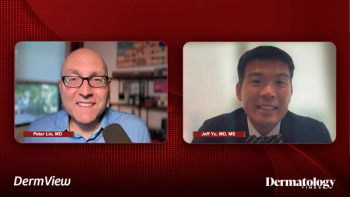
Treatment and Patient Guidance in Vitiligo
Nada Elbuluk, MD, and David Rosmarin, MD, discuss the role of the health care provider in helping patients understand their vitiligo and treatment options.
Episodes in this series

Nada Elbuluk, MD: The other thing you brought up, which is important, is finding out what their goal is. I always ask the patient, “What’s your goal from your visit today? What made you come in?” Someone might come in at the onset of the first white spot they notice, but someone else who comes in has had it for decades. Sometimes they’re coming because they want to know, is there anything new? Has anything changed? Not every patient is seeking treatment, although many are. The majority of mine who come to clinic are. Many of these people have been told that not much can be done. Or they might have tried something for a limited time and failed. I try to make it an educational experience. I find out what they’re looking for so that, at the end of the visit, I’ll feel I accomplished their goals.
David Rosmarin, MD: You hit the nail on the head. A lot of education takes place during these visits. I want to build on what you commented on, for quality of life. Our measures show that, when patients have it in exposed areas, that tends to affect their quality of life. Even more so than in the exposed areas if patients have progressive or unstable disease. They have anxiety over not knowing when they’ll get a new spot. The unpredictability that happens with nonsegmental vitiligo can be quite bothersome to patients, more than even having their disease in the first place. But it’s always important to find out, what’s the goal of the patient? Some may be happy with halting the progression. The majority, in my experience, would like their pigment back.
Nada Elbuluk, MD: I agree. For a lot of people, we give them hope that there are options. There’s a lot of misperception out there. Even patients who’ve been seen by physicians have sometimes been told there’s not much that can be done, that they have to live with this. That’s not the case. We don’t have a cure for vitiligo, but we have treatment options, many of which can be effective, many of which can bring pigmentation back. I try to give them that hope. I explain that it’s not a fast process. It doesn’t happen overnight. It involves time, the work of them doing the treatment and complying with it. If they’re OK with putting in that work, many people do well with that. It’s important to make that clear to patients.
David Rosmarin, MD: We view repigmentation as a 2-step process. It takes only an overactive immune system to destroy the pigment cells. To get them back, first you need to make the environment more hospitable and calm the immune system down. Second, to have that normal skin color back, those pigment cells, or melanocytes, have to migrate back to the white patches, to the depigmented skin. That process takes more time. It usually comes from the follicles, so follicularly dense areas like the head and neck are more rapid and easier to repigment and more glabrous areas that lack follicles are much more challenging to repigment.
We do it in the context of this 2-step process, and that’s why it takes time. We’re lucky that in diseases like psoriasis and atopic dermatitis, we can see response fairly rapidly, within the first few months, even within weeks. With vitiligo, we need to give it time. That’s why I stretch out the visits and emphasize to patients that they give it time. I take pictures at baseline and then at 6 months, so I’m objective at comparing how they’re doing. As long as they’re still improving, I’m going to continue treatment. That’s my personal for conducting visits. I always counsel patients that vitiligo repigmentation takes time.
Nada Elbuluk, MD: I agree, David. I typically see them every 3 months if they’re able to come in. I love that you mentioned photos. Photography is essential, because people look at their skin every day. They can’t necessarily see or remember the progress. We see too many patients to remember every person’s case. Photographs are powerful, and we use those when they come back for follow-up visits. I explain to them that when we’re seeing follicular repigmentation, and they’re seeing little dots come up, that means the process is working. That’s how it starts. They can at least feel encouragement, even if a patch hasn’t repigmented 100%, that they’re on their way when we seeing that follicular repigmentation.
David Rosmarin, MD: It’s interesting that when I first see follicular repigmentation, as a provider, I’m excited. This treatment is helping. But sometimes that’s correlated with a worsening in the quality of life because patients feel as if they look worse with the spotting that happens. Some reassurance and hand holding is needed before it repigments more fluidly and they get to their desired result.
Nada Elbuluk, MD: Going back to quality of life, that first visit with a patient with vitiligo can be long and emotional for patients. It’s important that we address some of that psychosocial burden. I try to understand what they’re doing in their daily life. Are they in school? Are they working? Are they home? Sometimes you’ll find people completely re-treated into an isolated existence because of their vitiligo, which we don’t want. I ask some of those patients if they’re in therapy. There are many support groups for vitiligo, which is amazing. I try to connect them with a local support group. If there isn’t 1, then with a national support group, which they can connect with online. I also recommend seeing a psychiatrist if it seems necessary. Addressing that component is critical.
David Rosmarin, MD: I agree. I’ll usually recommend support groups that are local to my area. Those can be quite helpful in connecting people with others who have similar experiences. That bonding experience can be powerful. They will have support for some of the treatments that they may undergo, which can take time. Those are key concepts that people get from the support groups. I’m sure we’ve all heard those devastating stories from patients who feel like they’re being stared at. They don’t want to go to restaurants. They feel like people don’t want to take their money. They feel like it affects their relationships. I agree support groups can be quite helpful.
Transcript edited for clarity
Newsletter
Like what you’re reading? Subscribe to Dermatology Times for weekly updates on therapies, innovations, and real-world practice tips.


















